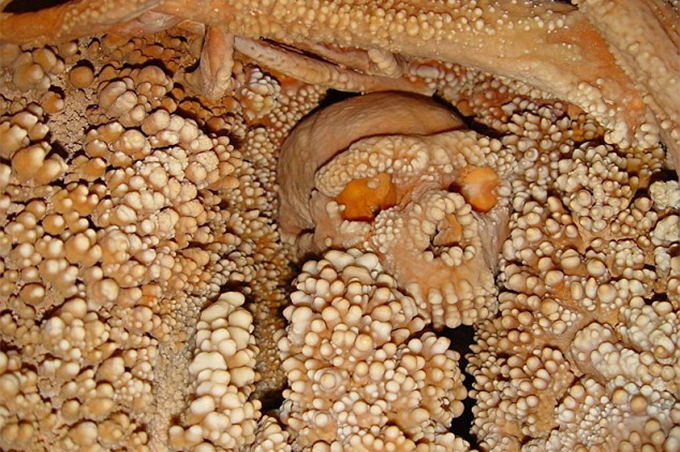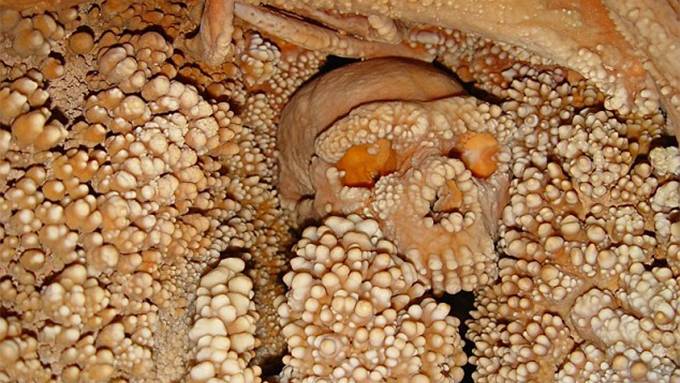Oldest Neanderthal DNA Found in Italian Skeleton
Source: livescience.com

The calcite-encrusted skeleton of an ancient human, still embedded in rock deep inside a cave in Italy, has yielded the oldest Neanderthal DNA ever found.
These molecules, which could be up to 170,000 years old, could one day help yield the most complete picture yet of Neanderthal life, researchers say.
Although modern humans are the only remaining human lineage, many others once lived on Earth. The closest extinct relatives of modern humans were the Neanderthals, who lived in Europe and Asia until they went extinct about 40,000 years ago. Recent findings revealed that Neanderthals interbred with ancestors of today's Europeans when modern humans began spreading out of Africa — 1.5 to 2.1 percent of the DNA of anyone living outside Africa today is Neanderthal in origin.
In 1993, scientists found an extraordinarily intact skeleton of an ancient human amidst the stalactites and stalagmites of the limestone cave of Lamalunga, near Altamura in southern Italy — a discovery they said had the potential to reveal new clues about Neanderthals.
"The Altamura man represents the most complete skeleton of a single nonmodern human ever found," study co-author Fabio Di Vincenzo, a paleoanthropologist at Sapienza University of Rome, told Live Science. "Almost all the bony elements are preserved and undamaged."
The Altamura skeleton bears a number of Neanderthal traits, particularly in the face and the back of the skull. However, it also possesses features that usually aren't seen in Neanderthals — for instance, its brow ridges were even more massive than those of Neanderthals.These differences made it difficult to tell which human lineage the Altamura man might have belonged to. Moreover, the Altamura skeleton remains partially embedded in rock, making it difficult to analyze.
Now, new research shows that DNA from a piece of the skeleton's right shoulder blade suggests the Altamura fossil was a Neanderthal. The shape of this piece of bone also looks Neanderthal, the researchers said.
In addition, the scientists dated the skeleton to about 130,000 to 170,000 years old. This makes it the oldest Neanderthal from which DNA has ever been extracted. (These bones are not the oldest known Neanderthal fossils — the oldest ones ever found are about 200,000 years old. This isn't the oldest DNA ever extracted from a human, either; that accolade goes to 400,000-year-old DNA collected from relatives of Neanderthals.)
The bone is so old that its DNA is too degraded for the researchers to sequence the fossil's genome — at least with current technology. However, they noted that next-generation DNA-sequencing technologies might be capable of such a task, which "could provide important results on the Neanderthal genome," study co-author David Caramelli, a molecular anthropologist at the University of Florence in Italy, told Live Science.
Whereas previous fragmentary fossils of different Neanderthals provided a partial picture of what life was like for Neanderthals, the Altamura skeleton could help paint a more complete portrait of a Neanderthal — for instance, it could reveal more details about Neanderthals' genetics, anatomy, ecology and lifestyle, the researchers said.
"We have a nearly complete human fossil skeleton to describe and study in detail. It is a dream," Di Vincenzo said. "His morphology offers a rare glimpse on the earliest phase of the evolutionary history of Neanderthals and on one of the most crucial events in human evolution. He can help us better understand when — and, in particular, how — Neanderthals evolved."
The scientists detailed their findings online March 21 in the Journal of Human Evolution.
Source: livescience.com
Tune into Red Ice Radio:
Danny Vendramini - Them & Us: Neanderthal Predation Theory






















